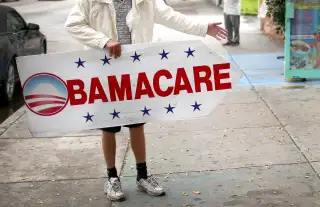Obamacare Repeal: What You Need to Know Right Now

Congress laid the groundwork late last week for the repeal of the Affordable Care Act, with both the Senate and the House voting on a budget plan that would help dismantle President Obama’s signature achievement, also known as Obamacare.
Even as the Republican-led Congress acts quickly on President-elect Donald Trump’s campaign promise to repeal the health insurance law, there remain many questions about what might replace it, and when. That leaves plenty of uncertainty for the 20 million Americans who have gained insurance coverage under the law.
Money talked to experts to bring you answers to three common questions.
What will happen next as Congress moves to undo Obamacare?
Many Congressional Republicans have wanted to repeal Obamacare since it was first passed in 2010. They voted on repeal many times over the years, but their efforts went nowhere under President Obama, who wielded veto power.
With Trump taking office next week, the coast is clear for the Republican-led Congress to proceed with repeal. Thing is, that’s much easier said than done. Overhauling the country’s health insurance system required a massive effort back in 2010, and replacing it will also require a heavy lift.
What’s more, Republicans are hardly in lock-step agreement about how to proceed. There are two major schools of thought, and leaders say neither would rip coverage from Obamacare consumers: “repeal and delay” and “repeal and replace.”
The repeal-and-delay approach would repeal Obamacare as soon as possible, giving Republicans a symbolic victory. But it would delay the effective dates of key aspects of the repeal for a number of years. That way, consumers would not lose coverage abruptly, and lawmakers would not bear the political fallout of constituents’ outrage before the 2018 Congressional midterm elections. Under this scenario, the current system would continue largely as-is for a few years until a replacement plan is passed.
The repeal-and-replace route, by contrast, would see Congress repeal Obamacare and pass a replacement bill soon thereafter. At his news conference on Wednesday, Trump spoke in favor of this approach, saying that an Obamacare replacement would come nearly simultaneously with repeal.
As to what a replacement might look like, lawmakers have put forth various plans in various stages of readiness, says Larry Levitt, senior vice president for the Kaiser Family Foundation, a nonprofit organization working on national health issues. Some approaches haven’t even been put into legislative language.
Yet they share some common themes. The proposals would generally favor younger consumers over older consumers—the former would likely pay less for coverage than they currently do, while the latter would pay more. Insurers would also be able to charge women more than men for coverage, a practice that the Affordable Care Act banned. Replacement plans would generally be less friendly toward people with pre-existing conditions.
What should I do if I have or want Obamacare coverage?
Short answer: Stay the course, and move quickly to lock in the coverage for this year if you haven't already.
“As of now, all of the law’s benefits and requirements are still in place,” Levitt says.
Insurers have set their plans for 2017, and those are not expected to change for this calendar year. “Consumers should take the [incoming] administration at its word that there will be no interruption, and go about their business,” says Dan Mendelson, president of Avalere Health, a health-care consulting firm based in Washington.
Obamacare open enrollment for 2017 coverage ends on Jan. 31. That’s the last day you can enroll for the first time or switch plans for 2017, unless you qualify for a special enrollment period later in the year. (Coverage for consumers who sign up between Jan. 16 and 31 will begin no later than March 1; those who want coverage beginning Feb. 1 must sign up by this Sunday, Jan. 15.)
Enrollment this year has outpaced last year, with an increase of 286,000 plan selections over a comparable stretch last open enrollment, according to a recent report from the U.S. Department of Health and Human Services. More than 11.5 million people had signed up for Obamacare marketplace coverage as of Dec. 24, 2016, according to that report. (The remaining consumers who gained coverage under Obamacare did so through an expansion of the Medicaid program.)
What’s the worst that could happen for people depending on Obamacare?
Insurers are contractually committed to their plans for 2017. But they do have an escape clause of sorts: The law allows carriers to exit the market if they don’t receive certain payments from the government that reduce insurance costs for lower-income consumers. The Trump administration could act so that the U.S. Treasury does not make such payments to carriers. In that scenario, “Insurers won’t stick around and lose a ton of money,” Levitt says. The departures would cause “chaos” in the insurance market, he adds.
That market turmoil could mean life or death for certain consumers--say, certain patients in the middle of cancer treatment--and Republicans know this. While this worst-case scenario is unlikely, some say it can’t be completely discounted given the unpredictable political climate.